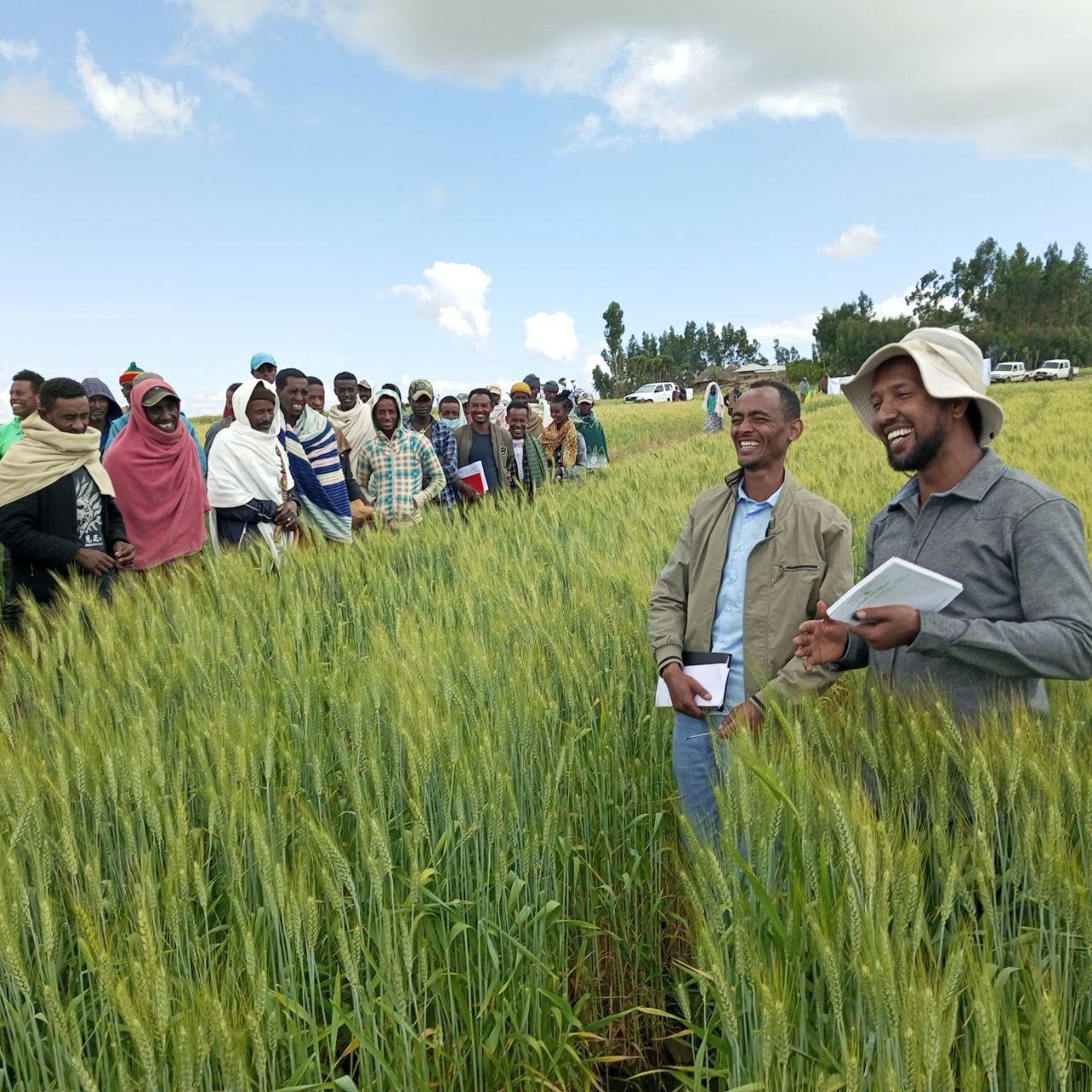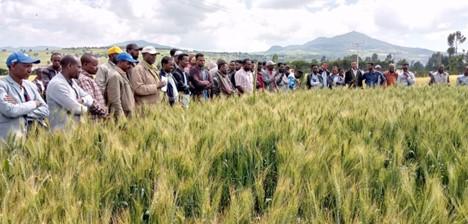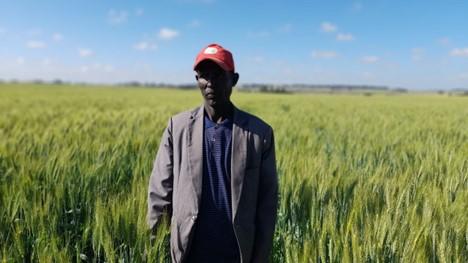From the Field For Ethiopian farmers, location-specific fertilizer makes a difference

In a series of field days, Alliance researchers and partners have piloted a context-specific approach for national and local stakeholders to improve wheat performance.
By: Feyera M Liben, Wuletawu Abera, Mohammed Ebrahim, Lulseged Tamene

Photo 1. Field day participants visited pilot plots and entertained questions with the Alliance and its partners (Digital Green, North Shoa Zone Agricultural Bureau, and Siyadebir Agricultural Bureau) on the new LSFR advisory at Siyadebir district. (photo credit: Alliance/Feyera M Liben)
Contrasting with widespread, blanket application of fertilizers, location-specific fertilizer recommendations (LSFR) can help farmers save resources, protect soil fertility, and achieve better results for crops.
The Alliance of Bioversity and CIAT and Digital Green organized field days at Lemo, Siyadebr, Basona Worena, and Goba districts of Ethiopia to demonstrate to farmers, partners, and stakeholders how the location-specific fertilizer recommendation (LSFR) improved wheat performance. This was held during the second and third weeks of the November 2022 cropping season. In the four districts, a total of 292 farmers and 173 extension workers participated in the field days. In addition, Agricultural Offices at the districts organized exchange visits at 56 Kebeles and reached 7729 farmers of which 728 were women and 7011 men were wheat growers. Crop Development and Extension Executive Chief Officers at the Ministry of Agriculture in Ethiopia, wheat growers, development agents, Zonal and District Agricultural Representatives, and experts were invited to visit pilot scaling wheat fields in the Goshebado Kebele. This is one of the sites which received LSFR advisory during the pilot scaling season.
One of the most important field days organized was at Siyadebir district in the Amhara region. The participants were first given a detailed explanation from Alliance researchers and partners about the location-specific fertilizer advisory pilot scaling (Photo 1), then Mr. Kefelegn Tariku, a smallholder farmer who hosted the LSFR advisory pilot on their field, explained the LFSR to the participants (Photo 2). Mr. Kefelegn Tariku was keen to note that the LSFR advisory significantly boosted wheat performance when he compared the pilot plot to the neighboring farmers and also his wheat fields that are managed following the blanket fertilizer recommendations.
“Look at the plant height, head width, and spike length which gave me the confidence to expect higher grain yield for my family and better straw for my livestock feed,”
a thrilled Mr. Tariku added. After visiting the pilot trial hosting the farmers’ field, participant farmers were interested in the new advisory and promised to implement the new LSFR in the 2023 main cropping season.

Photo 2. Mr. Kefelegn Tariku, a model farmer explained to field day participants (farmers, Digital Green, Siyadebir Agricultural Bureau, North Shoa Zone Agricultural Bureau, and Alliance) (1) the procedure he followed during pilot trial implementation and (2) the on-field performance of the wheat plots which received LSFR advisory. (photo credit: Alliance/Mohammed Ebrahim)
During on-field short discussions after the field visit, the North Shewa Agricultural Office Representative who visited the pilot plot during the field day at Siyadebir recommending scaling up for wider adoption and to closely work with MoA to get the new fertilizer advisory registered on the country extension package. The Representative also noted Digital Green produces quality video documents by recording practices important to implement the agro advisory. Finally, farmers and the partners promised to strengthen their relationship and push forward to further scale up and out the new fertilizer advisory for wider adoption in Ethiopia.
The other field day was held at Goba in the Oromia region (Photo 3). Pilot trial hosting farmer Mr. Alemayehu Jirru from Goba district in Oromia region (Photo 4) started explaining to field day participants about his fertilizer use saying,
“I attended some of the awareness creation sessions and trainings related to location-specific fertilizer application that was brought in by Alliance and Digital Green and applied the recommendation and am extremely happy for the outcome”.
He also explained that applying the same amount of fertilizer irrespective of the heterogeneity of fields and soil fertility status was too much a generalization and appreciated the innovation the project brought to provide targeted advisory for each plot. Furthermore, he remarked that through video demonstrations and on-field pilot scaling exercises, he understood that location-specific fertilizer advisory matched the conditions and requirements of his different plots. This motivated the model farmer to follow the Alliance advisory to grow wheat on his 2.75 ha of arable land. Compared to the previous year’s harvests from the same field, the model farmer expects 3 tones of additional wheat yield from this season. Most pilot scaling trials hosting farmers who participated in the field day at Goba also expect much better wheat grain and straw yields compared to the previous year's harvests.

Photo 3. Farmers and partners (Digital Green, Bale Zone Agricultural Bureau, Goba Agricultural Bureau, and the Alliance) and smallholder wheat growers visiting LSFR advisory pilot plots at Goba in Ethiopia. (photo credit: Alliance /Feyera M Liben).
Mr. Esayas Lemma, Crop Development Directorate, and Mrs. Yenenesh Egu, Director of Agricultural Extension at the Ministry of Agriculture in Ethiopia visited LSFR pilots during a field day organized at Basona Worena district in North Shao zone in Amhara region (Photo 5&6). During the pilot field visits, the Chief Executive Officers had a conversation with farmers on how the LSFR helped to improve wheat performance. From the field observations and discussions with local officers and farmers, the CEOs appreciated the performance of the wheat pilots which received the location-specific fertilizer advisory. During a discussion with Zonal Agricultural Representative Officers, the Alliance, and Digital Green, the CEOs recommended technical meetings to discuss and agree on the way the LSFR advisory can be piloted and/or scaled widely in the coming years. The CEOs also recommended the Alliance generate location-specific fertilizer recommendations for the other major crops in the country such as maize, barley, teff, malt barley, and durum wheat, which have a very high demand for commercial purposes.

Photo 4. Location-specific fertilizer advisory pilot scaling trial hosting smallholder farmers at Goba in the Oromia region, in Ethiopia. (photo credit: Alliance/Feyera M Liben)

Photo 6. Crop development and extension CEOs of the MoA discussing with the Alliance and its partners Digital Green and North Shoa Zonal Agricultural Bureau after the field day visit at Basona Worena. (photo credit: Alliance/Mohammed Ebrahim).
In addition, North Shewa zone agriculture extension coordinator Mr. Tale Lemma said,
“To boost production, agriculture should be supported with science and knowledge. In this regard, we are very happy and encouraged to see that the LSFR has great potential”.
He also noted that despite there being many instances where farmers apply lower fertilizer rates than recommended, there are also places where there is over-application of fertilizer by wheat growers such as at the Jiru and Siyadebir districts, and advised field day participant farmers to follow advisories generated by the Alliance for fertilizer optimization and to significantly reduce the risk of soil health associated with over-application of fertilizer.
Demand partner Digital Green registered 24,073 smallholder farmers from five districts who wanted to pilot the new LSFR advisory for wheat. During the 2022 cropping season, Alliance and Digital Green exposed 11,171 (89.4 % of the plan) farmers through training and video demonstration and 3387 (42.4%) implemented the new advisory despite the 2 times fertilizer cost and shortage of fertilizer in the 2022 crop season.
Appreciating the effort of the Alliance and its partners related to improved fertilizer to enhance crop production, the Bureau of Agriculture at Siyadebir district offered a certificate of recognition during a ceremony to acknowledge the support received by the Alliance and Digital Green and the associated wheat crop performance (Photo 7).

Photo 7. Certificate of recognition awarded to Bioversity International and CIAT by the Bureau of Agriculture at Siyadebr district.
Acknowledgement
The research is financed by the Deutsche Gesellschaft für Internationale Zusammenarbeit (GIZ) through the Supporting Soil Health Initiatives (SSHI) in Ethiopia which is funded by the Bill and Melinda Gates Foundation and the Excellence in Agronomy (EiA). The Accelerating Impacts of CGIAR Climate Research in Africa (AICCRA) project has also supported different components of this research activity. We are also indebted to the great support we received from the Ministry of Agriculture and the Ethiopian Institute of Agricultural Research during the pilot scaling of the location-specific fertilizer advisory. The incredible support received from the Zonal and Woreda Bureaus of Agriculture, extension workers and farmers in the five districts where piloting is going on is sincerely appreciated as they are the basis of the success we see in the field.
